Depletion of Reflectance of Silicon Surface Textured Using Nano Second Fiber Laser
Abstract
1. Introduction
2. Experimental Methodology
3. Results and Discussion
3.1. Laser Irradiation
3.2. Surface Examination
3.3. Micro-Textured Surface Characterization
3.4. AFM Analysis
3.5. Fractal Dimensional (D) Analysis
3.6. Effect of Absorption and Reflectance without Surface Texturization
3.7. Effect of Absorption and Reflectance with Surface Texturization
4. Conclusions
- Uniform micro-texture with different shapes and sizes (circle and pyramid) were obtained in the order of incident laser wavelength by varying the important laser parameters.
- The reflectivity of this textured surface (pyramid) was below 8% compared to untextured silicon at 40%, and absorptance increased from 1% to 2% in the wavelength range of 200 to 1000 nm.
- After comparing the absorptivity and reflectivity graphs together, we found that the triangular dimple (pyramid) with decreased size (70 µm) showed a significant increase in absorptivity and a similarly significant decrease in reflectivity as compared to the other samples.
- The complexity of the laser-textured surface with varied patterns (circle and pyramid) and untextured surfaces are quantified by fractal dimension (FD) analysis.
- Despite being more expensive than other texturing methods, the process produces more critical and comprehensive results.
Author Contributions
Funding
Data Availability Statement
Conflicts of Interest
References
- Chand, M.; Mehta, A.; Sharma, R.; Ojha, V.N.; Nationa, K.P.C.; Marg, K.S.K. Roughness measurement using optical profiler with self-reference laser and stylus instrument—A comparative study. Indian J. Pure Appl. Phys. 2011, 49, 335–339. [Google Scholar]
- Radfar, B.; Es, F.; Nasser, H.; Akdemir, O.; Bek, A.; Turan, R. Effect of Laser Parameters and Post-Texturing Treatments on the Optical and Electrical Properties of Laser Textured c-Si Wafers. In Proceedings of the 8th International Conference on Crystalline Silicon Photovoltaics, Lausanne, Switzerland, 19–21 March 2018. [Google Scholar]
- Dasgupta, K.; Ray, S.; Mondal, A.; Gangopadhyay, U. Review on different front surface modification of both n+-p-p+ and p+-n-n+ C- Si solar cell. Mater. Today Proc. 2017, 4, 12698–12707. [Google Scholar] [CrossRef]
- Schwarz-Selinger, T.; Cahill, D.G.; Chen, S.-C.; Moon, S.-J.; Grigoropoulos, C.P. Micron-scale modifications of Si surface morphology by pulsed-laser texturing. Phys. Rev. B 2001, 64, 155323. [Google Scholar] [CrossRef]
- Lee, B.G.; Lin, Y.-T.; Sher, M.-J.; Mazur, E.; Branz, H.M. Light Trapping for Thin Silicon Solar Cells by Femtosecond Laser Texturing. In Proceedings of the 38th IEEE Photovoltaic Specialists Conference, Austin, TA, USA, 3–8 June 2012; pp. 001606–001608. [Google Scholar] [CrossRef]
- Basher, M.K.; Hossain, M.K.; Akand, M.A.R. Effect of surface texturization on minority carrier lifetime and photovoltaic performance of mono-crystalline silicon solar cell. Int. J. Light Electron Opt. 2019, 176, 93–101. [Google Scholar] [CrossRef]
- Bougoffa, A.; Trabelsi, A.; Zouari, A.; Dhahri, E. Analytical model of front texturization effect on silicon solar cell with porous silicon at the backside. Opt. Quantum Electron. 2016, 49, 16. [Google Scholar] [CrossRef]
- Demir, A.G.; Maressa, P.; Previtali, B. Fibre laser texturing for surface functionalization. Phys. Procedia 2013, 41, 759–768. [Google Scholar] [CrossRef]
- Dobrzański, L.A.; Drygała, A. Laser Application in Photovoltaics for Surface Texturization of Silicon and Front Electrode Deposition. Mater. Perform. Charact. 2019, 8, 20190061. [Google Scholar] [CrossRef]
- Sai, H.; Fujiwara, H.; Kondo, M.; Kanamori, Y. Enhancement of light trapping in thin-film hydrogenated microcrystalline Si solar cells using back reflectors with self-ordered dimple pattern. Appl. Phys. Lett. 2008, 93, 143501. [Google Scholar] [CrossRef]
- Eisenhauer, D.; Sai, H.; Matsui, T.; Koppel, G.; Rech, B.; Becker, C. Honeycomb micro-textures for light trapping in multi-crystalline silicon thin-film solar cells. Opt. Express 2018, 26, A498. [Google Scholar] [CrossRef]
- Nayak, B.K.; Iyengar, V.V.; Gupta, M.C. Efficient light trapping in silicon solar cells by ultrafast-laser-induced self-assembled micro/nano structures. Prog. Photovolt Res. Appl. 2011, 19, 631–639. [Google Scholar] [CrossRef]
- Vinčiūnas, A.; Indrišiūnas, S.; Voisiat, B.; Račiukaitis, G.; Šimkienė, I.; Suzanovičienė, R.; Rėza, A.; Mažeikienė, R. Effect of Laser Patterning on Properties of Crystalline Si Photovoltaic Cells and Substrates. J. Laser Micro/Nanoeng. 2013, 8, 244–252. [Google Scholar] [CrossRef][Green Version]
- Prasad, K.N.; Syed, I.; Subbu, S.K. Laser dimple texturing—Applications, process, challenges, and recent developments: A review. Aust. J. Mech. Eng. 2019, 20, 316–331. [Google Scholar] [CrossRef]
- Farrokhi, H.; Zhou, W.; Zheng, H.Y.; Li, Z.L. Non-ablative texturing of silicon surface with a continuous wave fiber laser. Opt. Express 2012, 20, 23180–23185. [Google Scholar] [CrossRef]
- Vidhya, Y.E.B.; Vasa, N.J. Numerical and Experimental analysis of nano second laser induced surface textures for light trapping in a-Si thin film for solar cells. Mater. Res. Express 2018, 5, 066410. [Google Scholar] [CrossRef]
- Joshi, K.; Bhandarkar, U.; Samajdar, I.; Joshi, S.S. Micro-structural characterization of thermal damage on silicon wafers sliced using wire-EDM. J. Manuf. Sci. Eng. 2018, 140, 091001. [Google Scholar] [CrossRef]
- Guu, Y.H. AFM surface imaging of AISI D2 tool steel machined by the EDM process. Appl. Surf. Sci. 2005, 242, 245–250. [Google Scholar] [CrossRef]
- Prabhu, S.; Vinayagam, B.K. AFM investigation in grinding process with nanofluids using Taguchi analysis. Int. J. Adv. Manuf. Technol. 2011, 60, 149–160. [Google Scholar] [CrossRef]
- Fashina, A.; Adama, K.; Abdullah, L.; Ani, C.; Oyewole, O.; Asare, J.; Anye, V. Atomic force microscopy analysis of alkali textured silicon substrates for solar cell applications. Int. J. Phys. Res. 2017, 6, 13–17. [Google Scholar] [CrossRef]
- Brown, M.S.; Arnold, C.B. Fundamentals of laser-material interaction and application to Multi scale surface modification. Laser Precis. Micro Fabr. 2010, 135, 91–120. [Google Scholar]
- Niu, C.; Zhu, T.; Lv, Y. Influence of Surface Morphology on Absorptivity of Light-Absorbing Materials. Int. J. Photoenergy 2019, 2019, 1476217. [Google Scholar] [CrossRef]
- Mahdieh, M.H.; Sobhani, M. Experimental Study of Nano-Structure and Optical Properties of Polished Silicon Irradiated by Nanosecond Nd:YAG Laser Beam. In Proceedings of the 15th International Conference on Laser Aided Plasma Diagnostics, Jeju, Republic of Korea, 13–19 October 2011. [Google Scholar]
- Raj, S.O.N.; Prabhu, S. Investigation on Slicing Behavior of Single Crystal Silicon Wafer in AWJM and Influence of Micro Dimple Textured Surface for Solar Applications. Silicon 2020, 13, 4481–4499. [Google Scholar] [CrossRef]

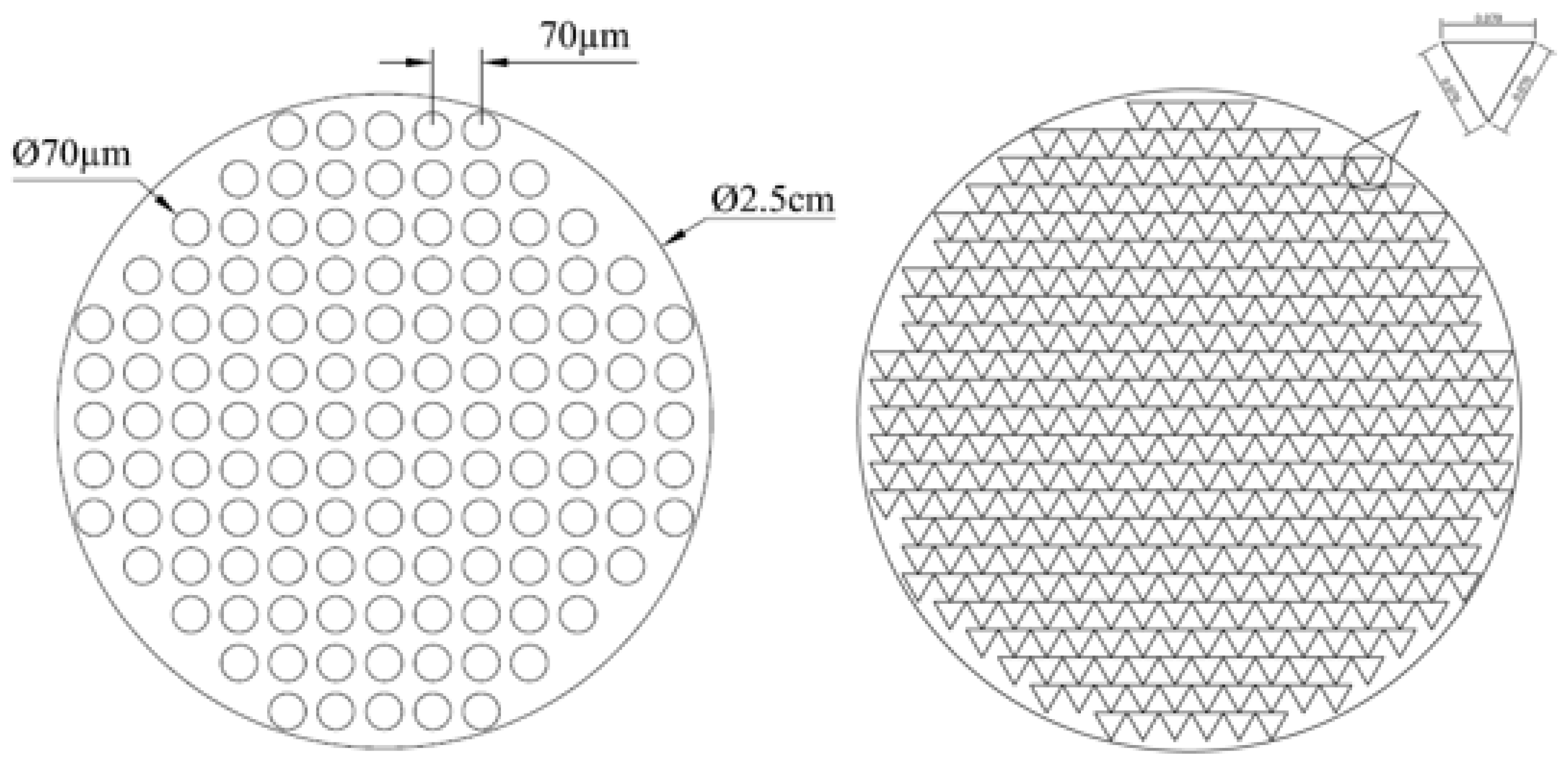
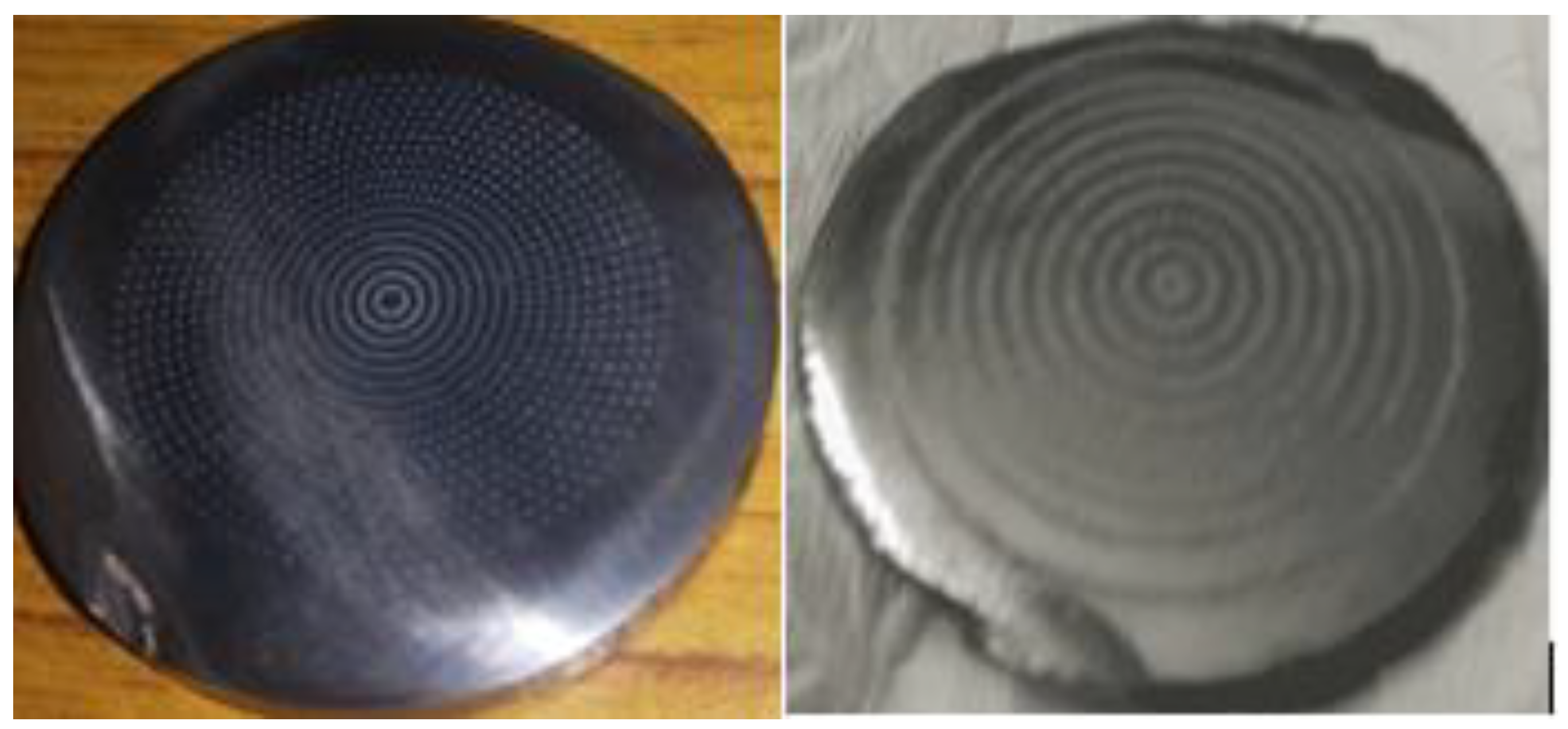
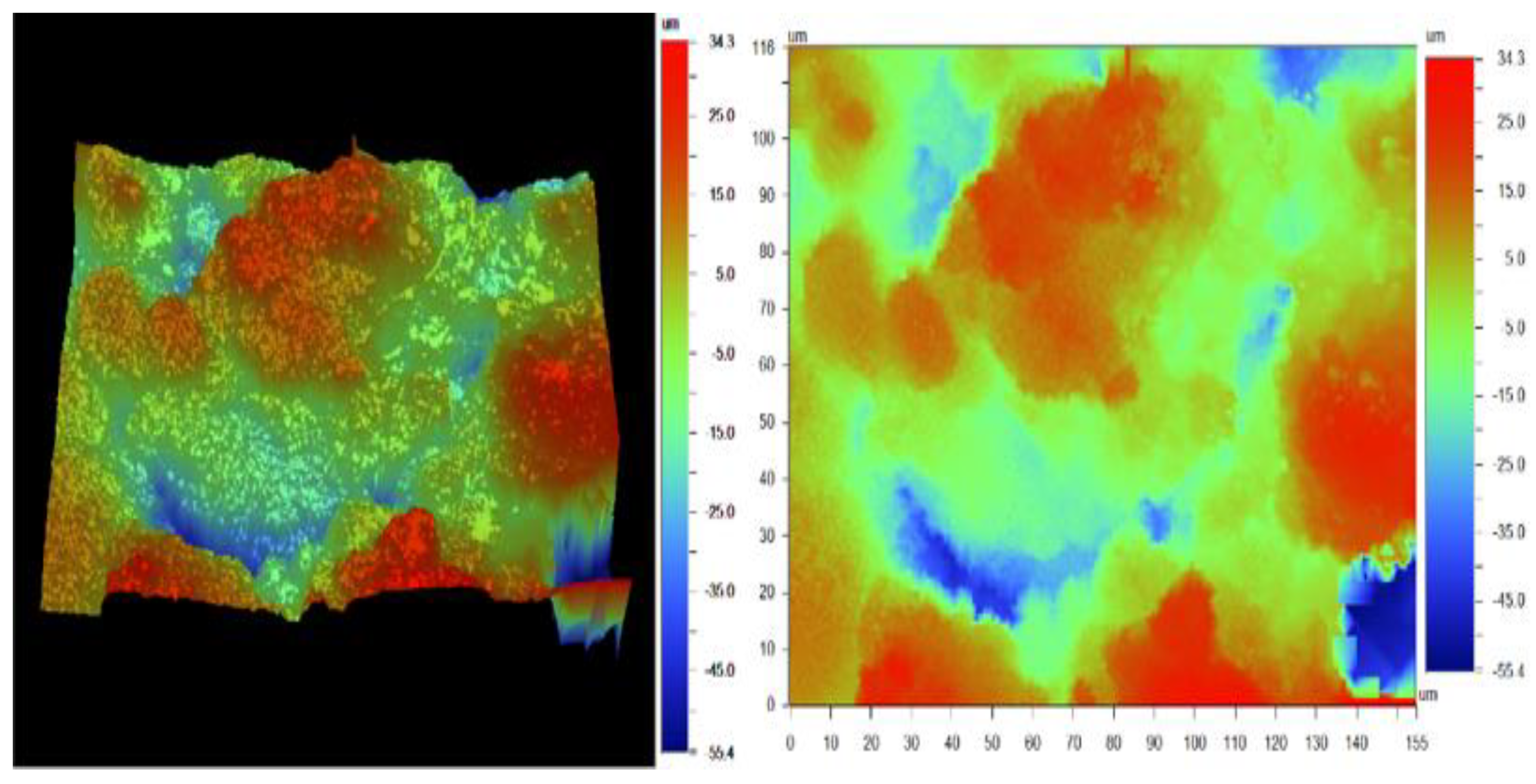


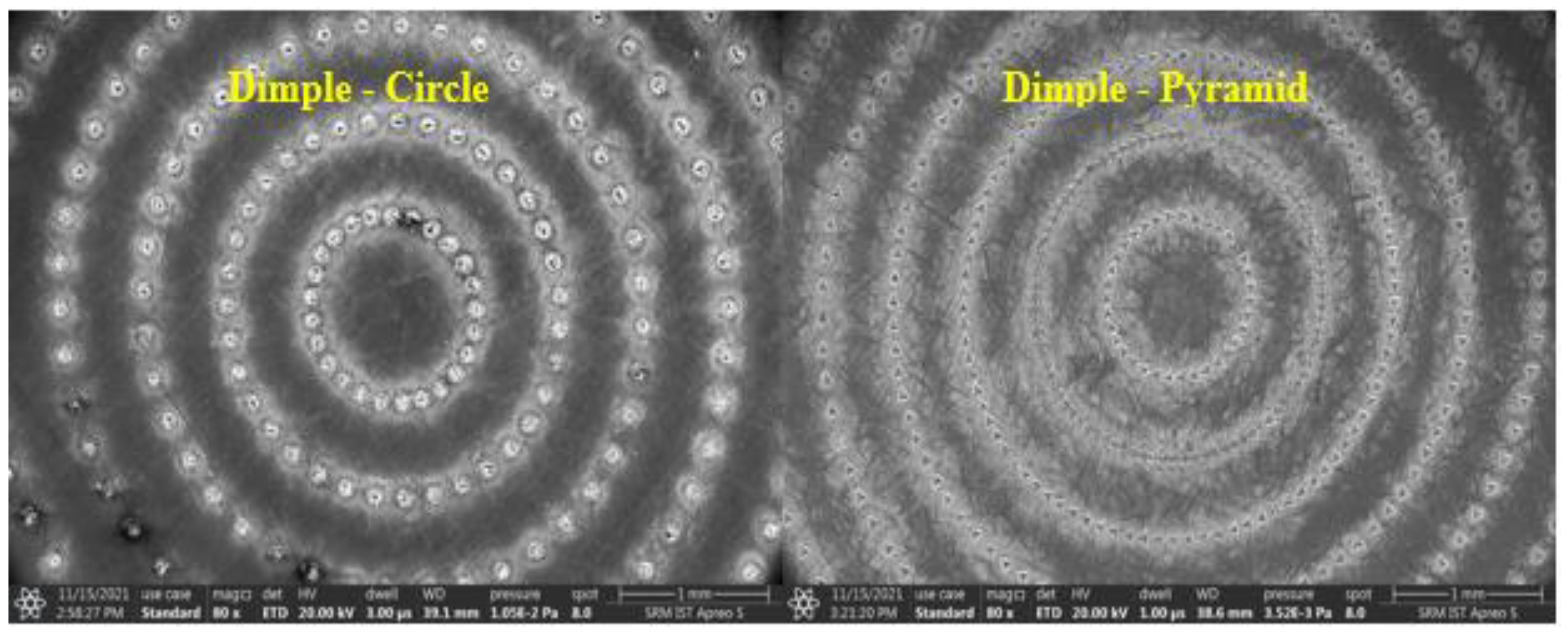
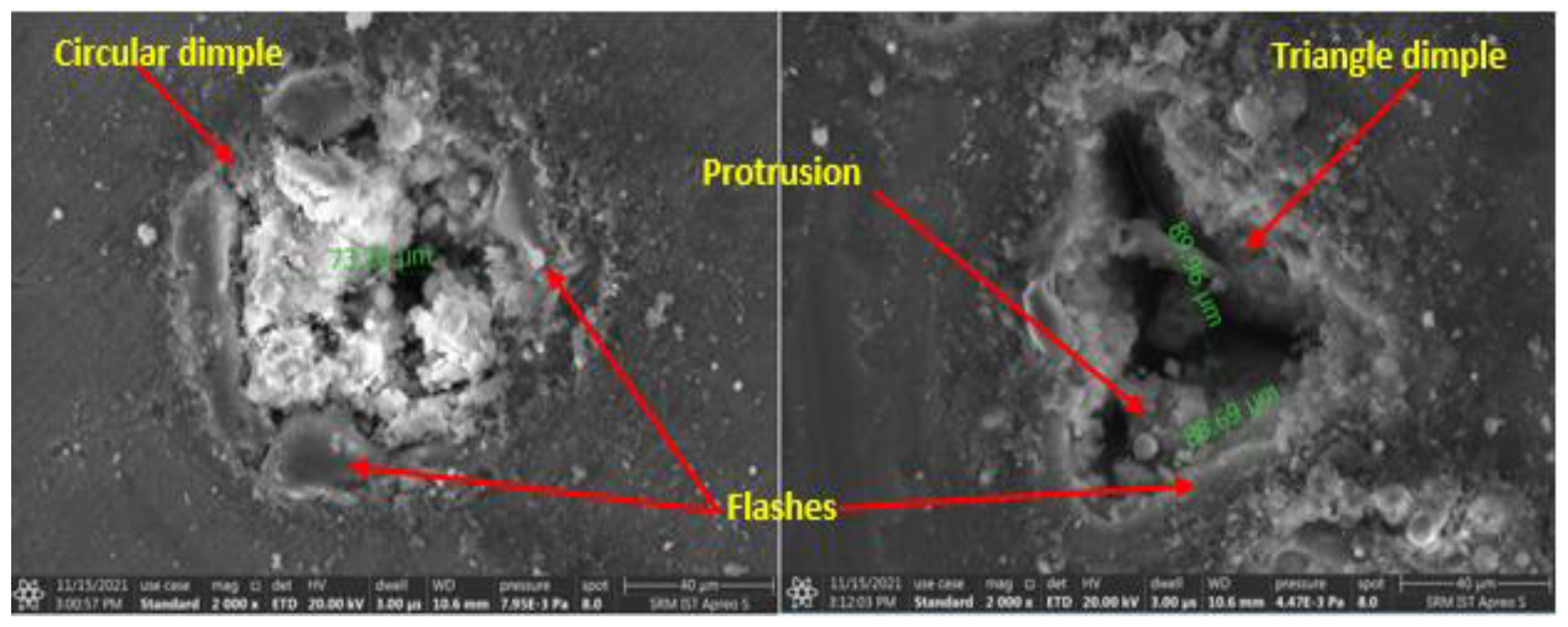
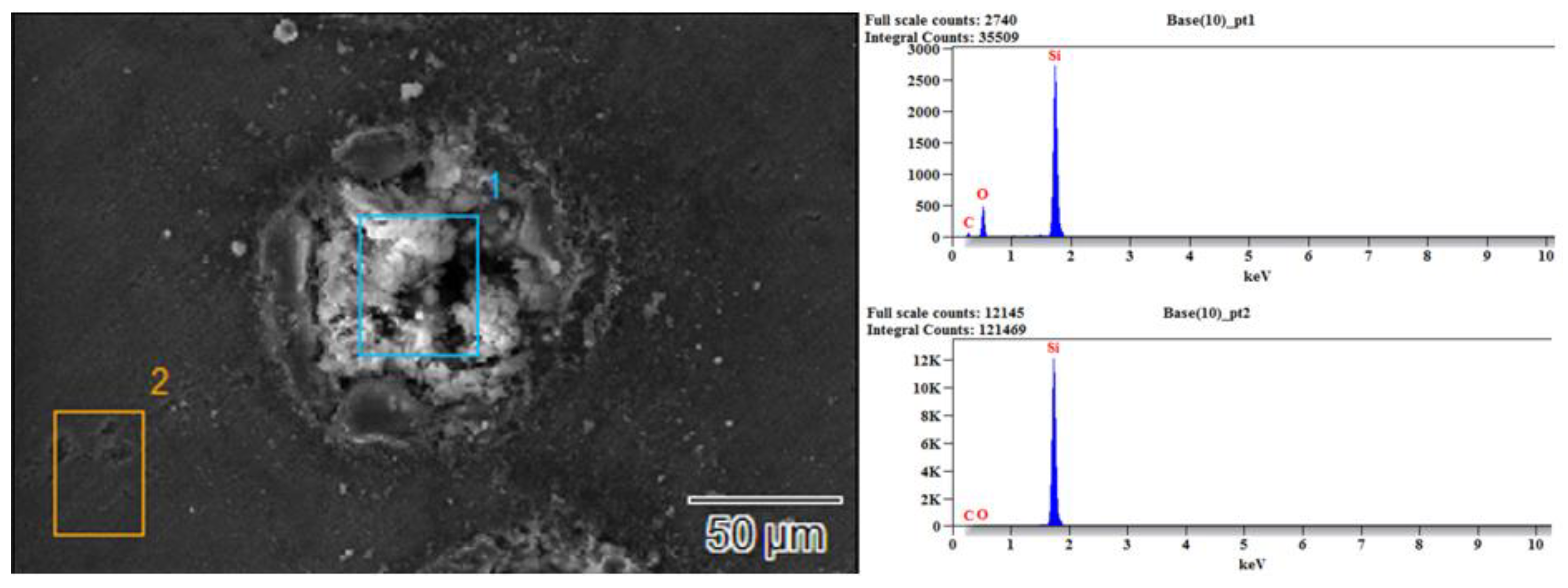

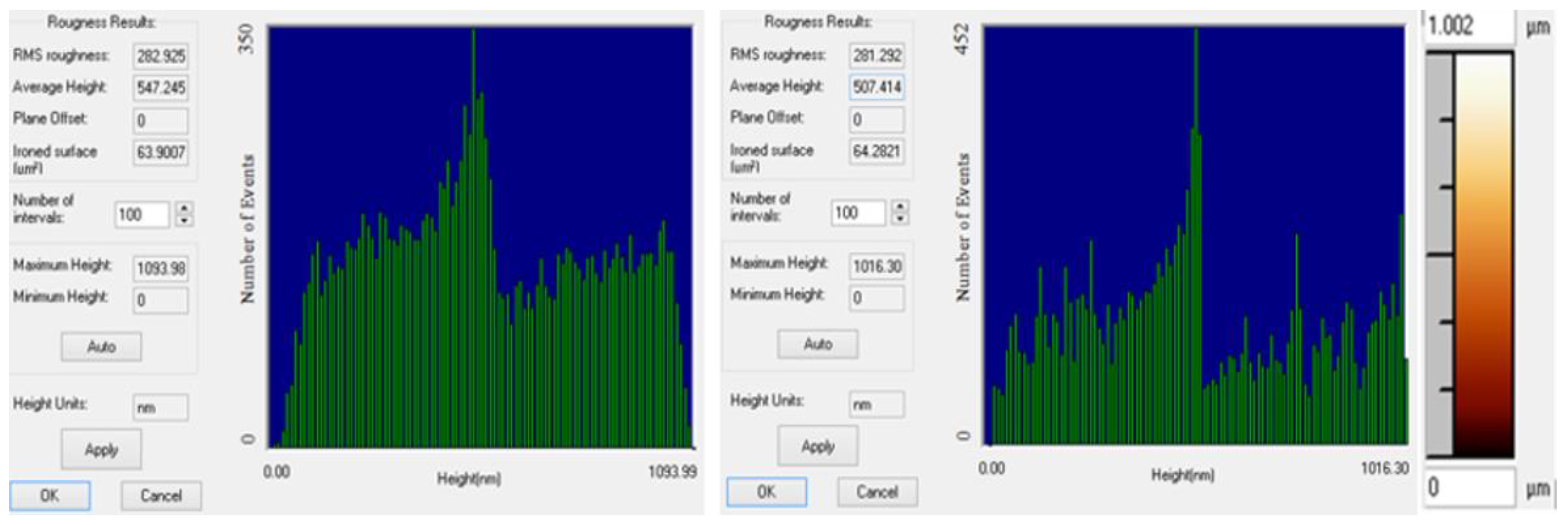

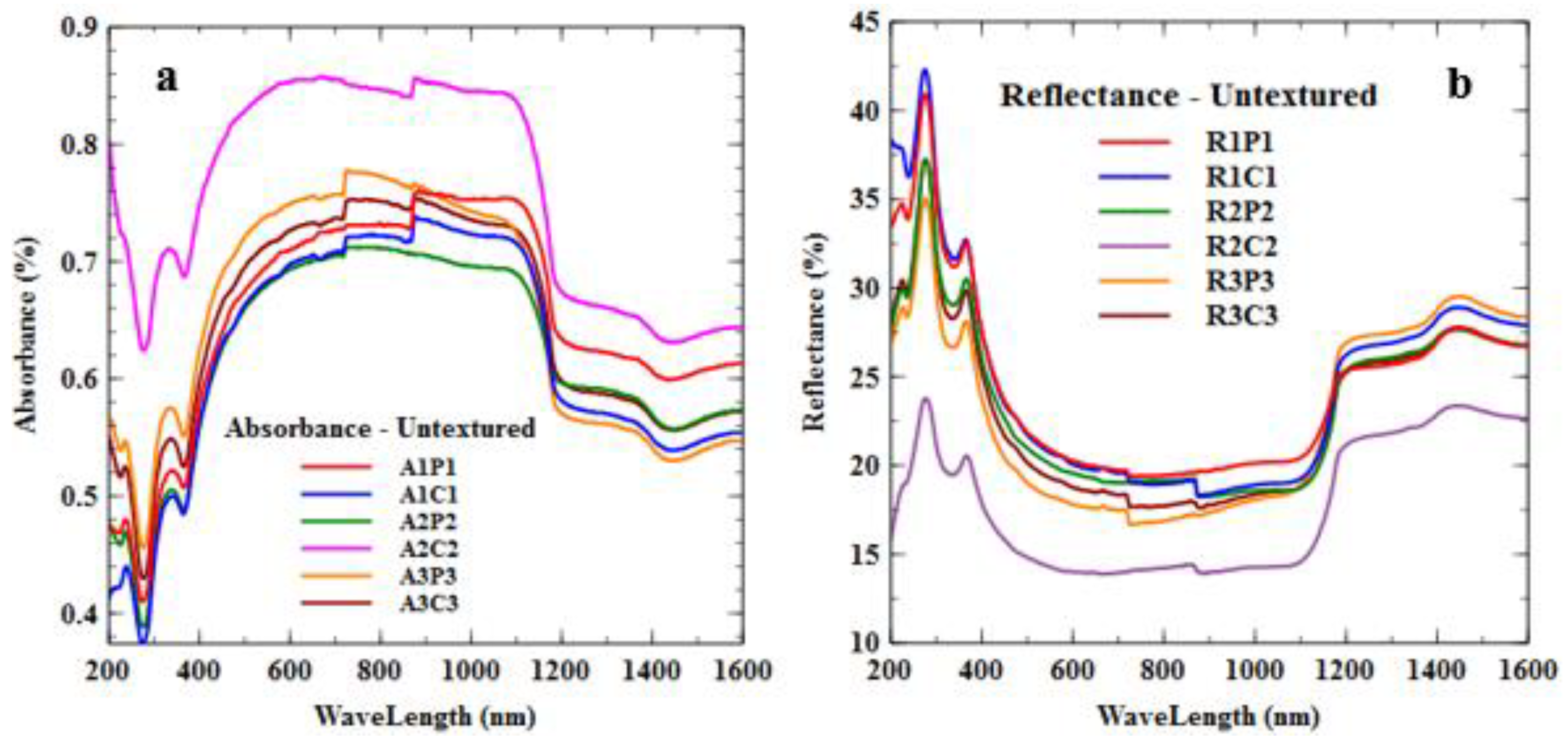
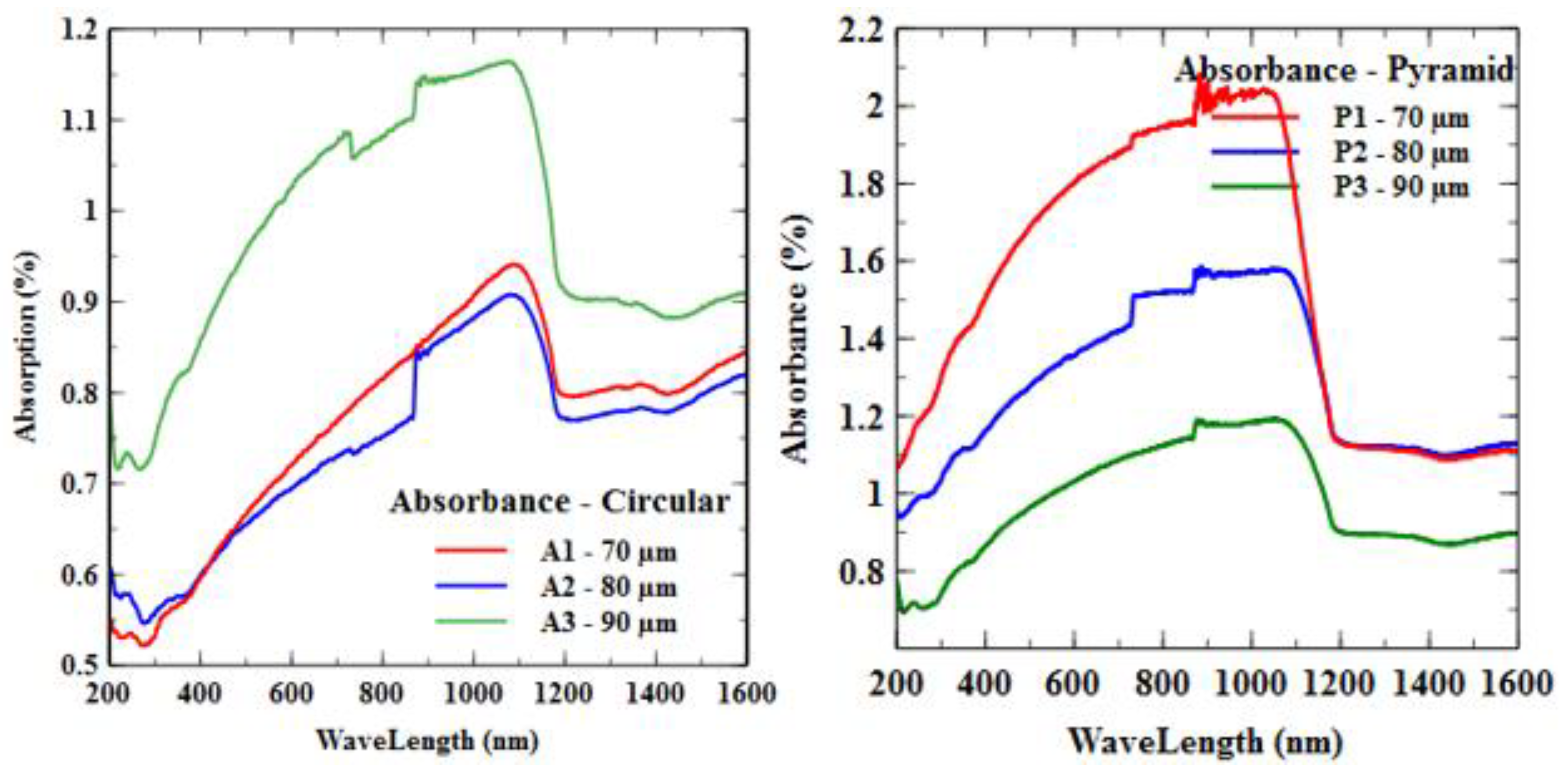

| Micro-Texturing Parameters | Unit | Dimple 70 µm | Dimple 80 µm | Dimple 90 µm |
|---|---|---|---|---|
| Wavelength | nm | 1064 | 1064 | 1064 |
| Pulse width | ns | 50 | 100 | 50 |
| Focal length | mm | 226 | 226 | 226 |
| Frequency | kHz | 40 | 50 | 60 |
| Pitch | µm | 70 | 80 | 90 |
| Laser pulse energy | mJ | 0.5 | 0.8 | 0.5 |
| Laser Power | W | 20 | 20 | 20 |
| No. of Pulses | 5 | 10 | 10 |
| Absorption % (Approx.) | Reflectance % (Approx.) | ||
|---|---|---|---|
| A1P1 | 0.4–0.5 | R1P1 | 35–40 |
| A1C1 | 0.4–0.45 | R1C1 | 38–45 |
| A2P2 | 0.45–0.5 | R2P2 | 30–38 |
| A2C2 | 0.6–0.8 | R2C2 | 15–25 |
| A3P3 | 0.45–0.55 | R3P3 | 30–35 |
| A3C3 | 0.5–0.55 | R3C3 | 30–35 |
| Dimple Pattern | Absorption % (Approx.) | Reflectance % (Approx.) | ||||
|---|---|---|---|---|---|---|
| 70 µm | 80 µm | 90 µm | 70 µm | 80 µm | 90 µm | |
| Circular | 0.55–0.85 | 0.60–0.80 | 0.70–1.15 | 28–30 | 25–28 | 18–20 |
| Pyramid | 1–2 | 1–1.5 | 0.8–1 | 8 | 12 | 20 |
Disclaimer/Publisher’s Note: The statements, opinions and data contained in all publications are solely those of the individual author(s) and contributor(s) and not of MDPI and/or the editor(s). MDPI and/or the editor(s) disclaim responsibility for any injury to people or property resulting from any ideas, methods, instructions or products referred to in the content. |
© 2023 by the authors. Licensee MDPI, Basel, Switzerland. This article is an open access article distributed under the terms and conditions of the Creative Commons Attribution (CC BY) license (https://creativecommons.org/licenses/by/4.0/).
Share and Cite
Oliver Nesa Raj, S.; Prabhu, S. Depletion of Reflectance of Silicon Surface Textured Using Nano Second Fiber Laser. Lubricants 2023, 11, 15. https://doi.org/10.3390/lubricants11010015
Oliver Nesa Raj S, Prabhu S. Depletion of Reflectance of Silicon Surface Textured Using Nano Second Fiber Laser. Lubricants. 2023; 11(1):15. https://doi.org/10.3390/lubricants11010015
Chicago/Turabian StyleOliver Nesa Raj, S., and Sethuramalingam Prabhu. 2023. "Depletion of Reflectance of Silicon Surface Textured Using Nano Second Fiber Laser" Lubricants 11, no. 1: 15. https://doi.org/10.3390/lubricants11010015
APA StyleOliver Nesa Raj, S., & Prabhu, S. (2023). Depletion of Reflectance of Silicon Surface Textured Using Nano Second Fiber Laser. Lubricants, 11(1), 15. https://doi.org/10.3390/lubricants11010015





